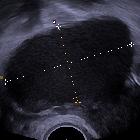Shading sign (endometrioma)












Shading sign is an MRI finding typically seen in an endometrioma. It may also be seen with some endometrioid tumors (e.g endometrioid carcinoma of the ovary).
It helps to distinguish endometriomas from other blood-containing lesions (e.g. hemorrhagic corpus luteum cysts), with a sensitivity of 90-92%, a specificity of 91-98% and a diagnostic accuracy of 91-96% .
The sign is seen on T2-weighted sequences of lesions that are hyperintense on T1, and consists of low signal (T2 shortening) affecting variable portions of the cyst. It may involve only a small portion of the cysts, typically layering dependently. Alternatively, it may involve the entire cyst. The signal is due to the high concentration of protein and iron within the endometrioma from recurrent hemorrhage. The degree of shading can vary from faint to complete signal loss.
Hemorrhagic adnexal cyst (most commonly, a corpus luteum cyst) may be bright on T1-weighted images, they are usually solitary and thin-walled and are brighter on T2-weighted images than are endometriomas. Marked loss of signal intensity on T2-weighted images is not usually seen with hemorrhagic cysts, since they do not repeatedly bleed. Without recurrent hemorrhage and concentration of contents, the viscosity of the cyst remains lower, and shading is unlikely to be present .
When noted with endometriosis, lesions demonstrating a shading sign may be less likely to respond to medical treatment .
Siehe auch:

 Assoziationen und Differentialdiagnosen zu shading sign:
Assoziationen und Differentialdiagnosen zu shading sign:

